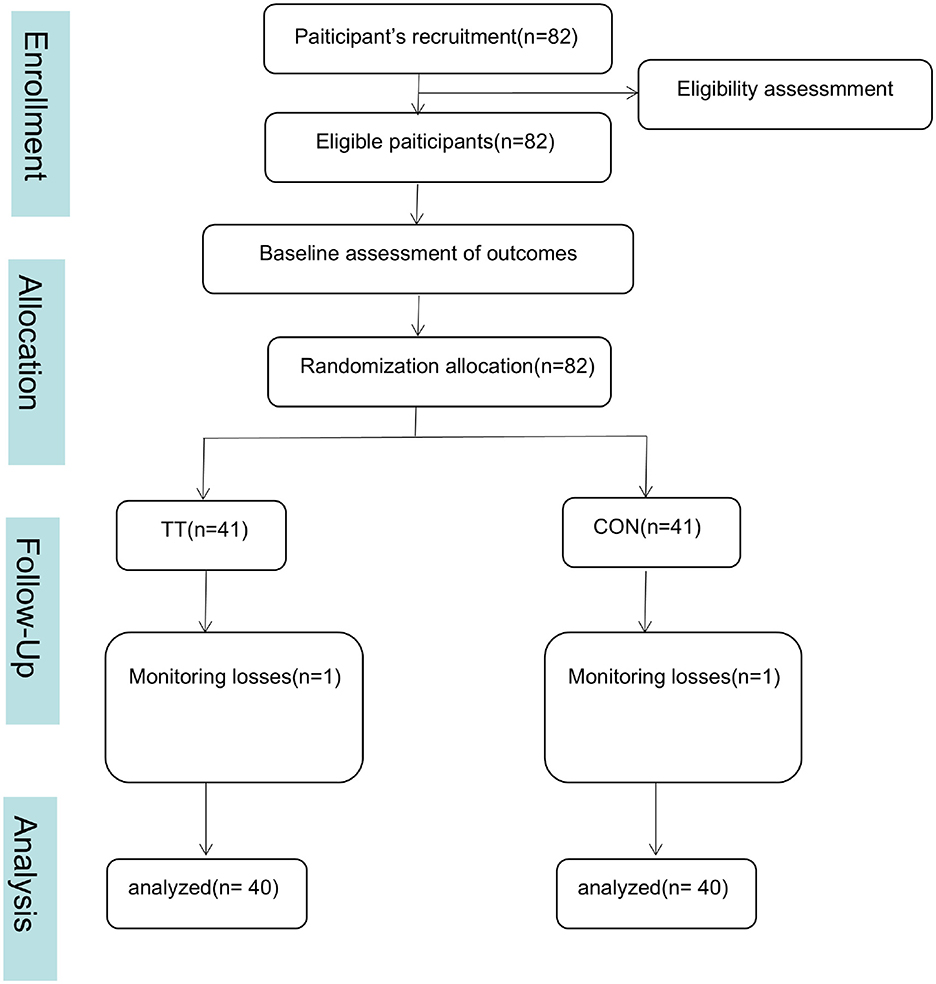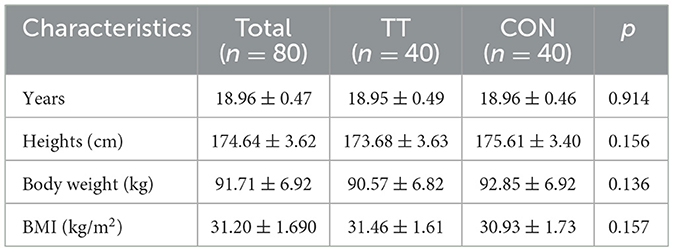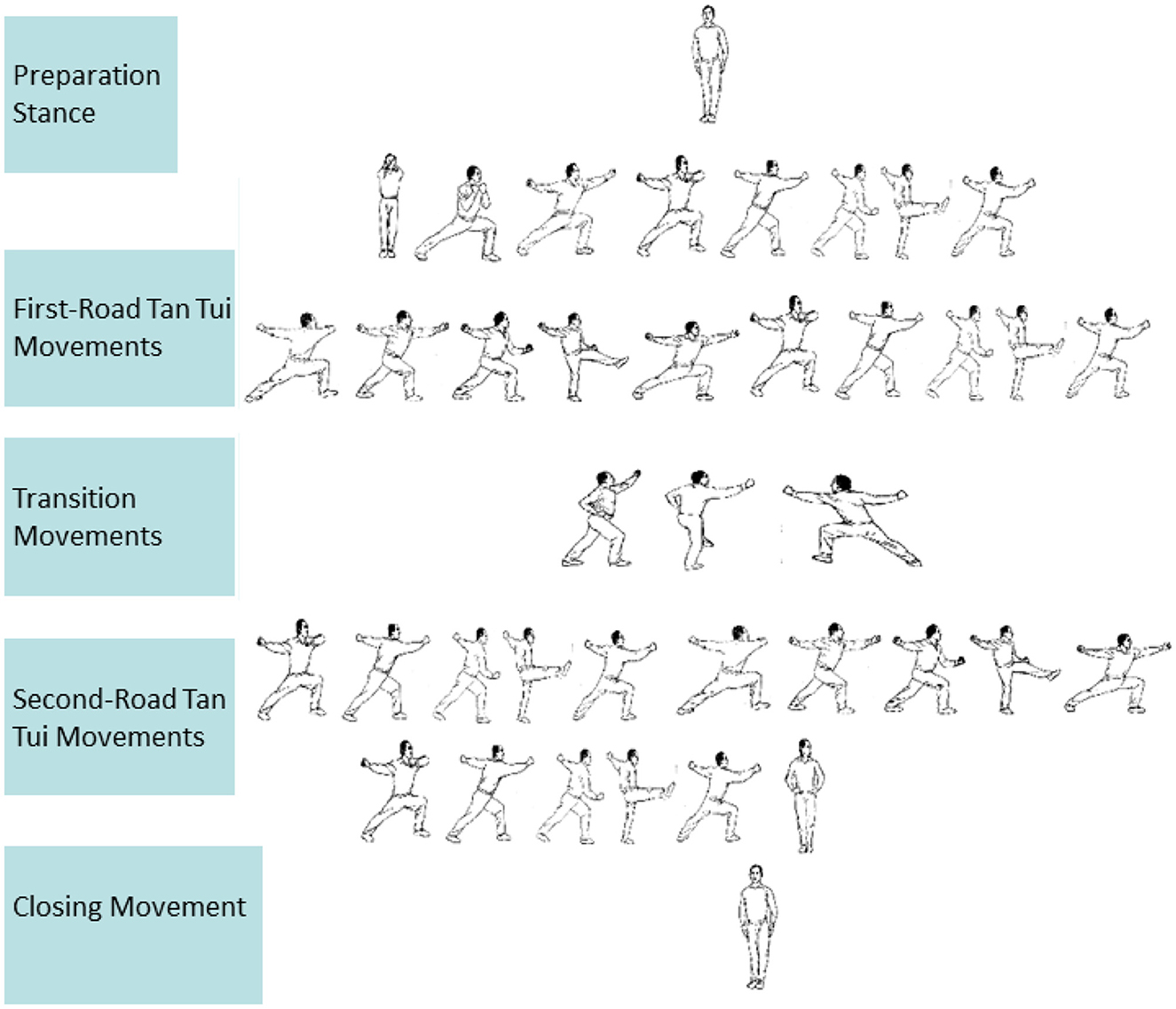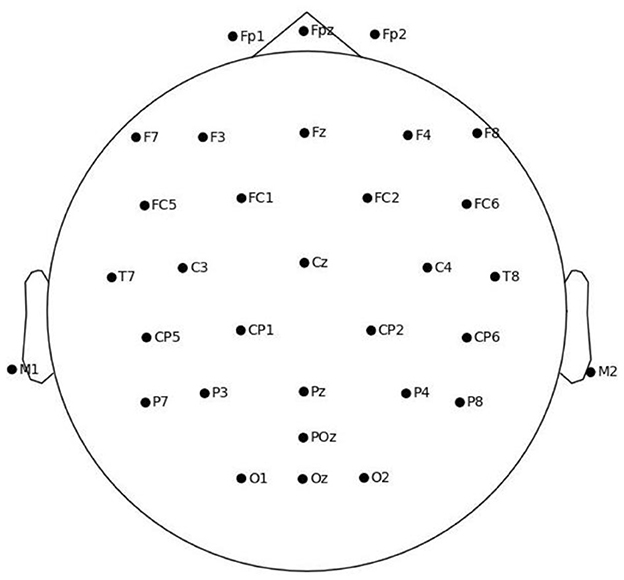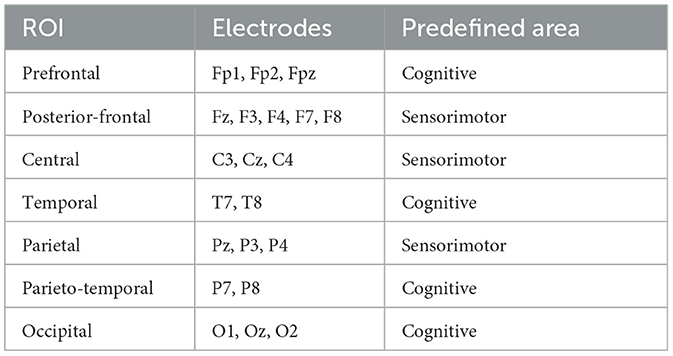- 1Department of Physical Education, Southeast University, Nanjing, Jiangsu, China
- 2Sports Department, Wenzhou Vocational College of Science and Technology, Wenzhou, Zhejiang, China
Objective: To investigate the effects of traditional martial arts Tan Tui practice on the brain mechanisms of postural control in obese college students.
Methods: Eighty obese college students were randomly divided into a Tan Tui practice group (TT) and a control group (CON), with 40 participants in each group. The TT group engaged in Tan Tui practice, while the CON group performed jogging. The intervention period was 14 weeks (3 times per week, 60 min each session). Absolute power of the alpha frequency band was assessed at baseline (pre-intervention) and after 14 weeks (post-intervention) for brain regions related to cognitive function and sensorimotor function.
Results: (1) Absolute Brain Power: Compared to the control group, the experimental group showed significant differences (p < 0.05) in alpha band power in brain regions associated with cognitive function (prefrontal: FP1, FPz, FP2; temporal: T8, P7; occipital: O1) and sensorimotor function (posterior frontal: F7, F3, FZ; parietal: P3, P4; central: C3, CZ). Compared to pre-intervention, the experimental group showed significant differences (p < 0.05) in alpha band power after training in cognitive function (prefrontal: FPz; temporal: T7, T8, P7, P8; occipital: O1) and sensorimotor function (posterior frontal, parietal, and central lobes). (2) Brain Region Symmetry: Compared to the control group, the difference in alpha band power between the left and right hemispheres of the occipital lobe (cognitive function) and central lobe (sensorimotor function) showed significant differences (p < 0.05) after training. Compared to pre-intervention, the experimental group showed significant differences (p < 0.05) in alpha band power after training in sensorimotor function (posterior frontal and central lobes). (3) Brain Region Synergy: Compared to pre-intervention, the experimental group showed a significant positive correlation (p < 0.05) in the synergy between the prefrontal and occipital lobes, and the temporal and occipital lobes, which are cognitive function brain regions. After training, there was a significant positive correlation (P < 0.05) in the synergy among sensorimotor function brain regions. Furthermore, after training, there was a significant positive correlation (p < 0.05) in the synergy between different sensorimotor function brain regions (posterior frontal, parietal, central) and cognitive function-related brain regions.
Conclusion: A 14-week systematic traditional martial arts Tan Tui training program can significantly enhance cortical excitability, improve functional symmetry between the left and right brain hemispheres, and strengthen the synergy among multiple brain regions in obese college students. Our findings demonstrate that traditional martial arts practice induces measurable neural plasticity and improves postural control and brain function in populations. This study links Tan Tui to modern neurophysiological evidence, offering novel insights into mind–body interventions for brain health in obesity.
1 Introduction
Obesity among college students has emerged as a growing global public health concern, associated with lifestyle changes (de Vos et al., 2015), academic stress (Hariyanto et al., 2025), and dietary imbalance (Choi, 2020). The overweight and obesity rates for young people aged 18–29 in China have reached 24.7 and 10.9%, respectively, making college students one of the high-risk groups for obesity (Jiang et al., 2018). International studies have found that the obesity rate for American college students is approximately 18.5% (Odlaug et al., 2015). Although the absolute prevalence of obesity in Chinese college students is still lower than in developed countries, longitudinal multicenter studies have shown a significantly faster growth trajectory, underscoring the potential health risks and the increasing prominence of movement disorders and postural control problems related to obesity (Hong et al., 2023).
Obesity leads to a shift in the body's center of gravity and increased load on the lower limb joints, which results in a decline in static balance ability, deficiencies in dynamic balance, and an increased risk of falls. Studies have found that obese college students perform poorly in single-leg standing and dynamic balance tests, with significantly greater sway compared to their normal-weight peers (Andreato et al., 2020; do Nascimento et al., 2017; Huang et al., 2024). Excess abdominal adiposity may mechanically restrict trunk mobility and alter neuromuscular recruitment of core muscles, thereby reducing trunk stability. Specifically, the activation efficiency of core and lower limb muscles is reduced, leading to a delay in postural adjustments (Almurdi, 2024) and a higher risk of falls (Debnath et al., 2024). Furthermore, proprioceptive sensitivity is reduced in obese individuals, weakening their motor perception. Plantar tactile sensitivity is reduced by 46% (Caderby et al., 2020), and a delay in proprioceptive input leads to an extension of postural adjustment reaction time by 200–300 ms (Garcia-Vicencio et al., 2023), which further affects postural stability (Strashko et al., 2022).
A distinctive feature of Chinese martial arts is the integration of internal elements—often described in traditional theory as Jing (essence), Qi (energy), and Shen (spirit)—with external physical movements, a concept that embodies the ancient Chinese cultural philosophy of the unity of form and spirit. The Tai Chi Chuan principle of using the mind to guide Qi, and using Qi to move the body, along with Hsing-I Chuan's emphasis on three internal and three external harmonies (Wang et al., 2011), are concrete manifestations of a foundational philosophy. Across various Chinese martial arts styles, the intricate fusion of the internal Jing, Qi, and Shen with external physical forms is essential for achieving a state where the mind moves, the form follows; the form stops, the intent continues. These practices collectively serve as a robust example of the core principles of internal and external cultivation and the unity of form and spirit. From a theoretical perspective, the traditional principles underlying Chinese martial arts—Jing, Qi, and Shen—can be viewed in modern scientific terms as reflecting physical capacity, psychophysiological regulation, and cognitive-emotional integration. These dimensions correspond to established constructs in sport psychology and motor learning, such as attentional focus, self-regulation, and embodied cognition, which are known to optimize motor performance and skill acquisition (Wulf and Lewthwaite, 2016; Schack and Mechsner, 2006). From a neuroscience perspective, this unity of internal and external elements parallels the coordination of neural mechanisms underlying motor control, interoception, and executive function (Craig, 2009).
Tan Tui, often referred to as the gateway to martial arts, is a foundational Chinese martial arts form. It is characterized by fast and powerful movements, symmetrical patterns, simple postures, ease of learning, and standardized stances (Wu and Wu, 2017). Professor Zhang Wenguang's works on Tan Tui have highlighted its potential benefits for developing strength, speed, and stability (Zhang, 1985). Ancient Chinese medical martial arts texts describe the benefits of Tan Tui as building strength, stabilizing stances, enhancing practicality, and strengthening sinews and bones, indicating its role in enhancing lower-limb strength and balance (Ren, 1985). Our previous research showed that 6 weeks of Tan Tui training with varying loads significantly improved postural control in non-obese college students, with improvements exceeding those observed in Tai Chi Chuan practice under similar conditions (Li et al., 2021). While these findings suggest that Tan Tui may be a particularly efficient modality for balance training, further studies are needed to confirm its relative efficacy.
In this study, we employed electroencephalography (EEG) to explore the neural responses associated with Tan Tui practice in obese college students. We hypothesized that Tan Tui training would be associated with measurable changes in EEG activity relevant to postural control. By examining these effects, we aim to provide evidence on how traditional martial arts exercise may influence neural processes related to motor coordination and balance in obesity. The findings may offer a neurophysiological reference for future exercise-based rehabilitation strategies for obese individuals. The present study proposes the following hypotheses: (1) Traditional martial arts Tan Tui can enhance the absolute power of brain activity in obese college students; (2) Traditional martial arts Tan Tui can improve interhemispheric symmetry in obese college students; (3) Traditional martial arts Tan Tui can enhance brain region synergy in obese college students.
2 Materials and methods
2.1 Research subjects
The sample size was estimated using G*Power 3.1.9 software (Faul et al., 2007). Based on the study's 2 (group) × 2 (time) experimental design, a repeated measures ANOVA was used to test the research hypothesis. Drawing on results from a previous study on the effects of Tan Tui practice on postural control in Tai Chi elective students, the post-training static balance for the experimental group was 111.94 ± 48.34 s, while the control group was 78.16 ± 40.76 s. With an alpha level of 0.05, a power of 0.80, and an allocation ratio of 1, the required sample size was estimated to be 58 participants. To account for potential dropout, while maintaining equal group allocation, the planned total sample size was set at 82 participants (41 per group).
Eighty-two obese college students were recruited from Beijing Sport University. This study was conducted in accordance with the Declaration of Helsinki. The research protocol was reviewed and approved by the Ethics Committee of Beijing Sport University (Approval No. 2021183H). All participants were fully informed of the study procedures and potential risks, and provided written informed consent prior to enrollment. Participants were enrolled if they met the following eligibility criteria: (1) non-physical education majors aged 18–24 years; (2) BMI ≥ 28 kg/m2 (Zhao et al., 2022); (3) good physical health with no contraindications for exercise; and (4) voluntary participation with signed informed consent. Potential participants were not eligible if they met any of the following exclusion conditions prior to enrollment: (1) inability to tolerate the exercise intensity of Tan Tui practice; (2) history of injury or surgery within the past 6 months; and (3) pre-existing diseases of the nervous or musculoskeletal systems.
Participants were randomly allocated to either the Tan Tui practice group (TT, n = 41) or the control group (CON, n = 41) using a computer-generated randomization sequence conducted by an independent researcher. Figure 1 illustrates the flow diagram of enrollment subjects. During the study period, one participant from the TT group and one participant from the control group were lost to follow-up. Therefore, the final analyzed sample size was 80 participants, consistent across all outcomes, ensuring that the study maintained sufficient statistical power.
As shown in Table 1, an independent samples t-test was conducted on participants' age, height, weight, and BMI (Table 1). The results revealed no significant differences (p > 0.05) between the groups for all variables, and all data were normally distributed.
2.2 Research methods
2.2.1 Intervention protocol
2.2.1.1 Tan Tui practice
2.2.1.1.1 Selection and standardization of Tan Tui movements
The intervention employed a customized “Two-Road Tan Tui” routine comprising 35 techniques, adapted from Professor Zhang Wenguang's Ten-Road Tan Tui. The rationale for movement selection was grounded in three criteria: simplicity of execution, functional practicality, and preservation of traditional characteristics.
The entire movement diagram is shown in Figure 2. To enhance reproducibility, we operationalized the movement set as follows (taking the left stance as an example):
• Preparation stance: standing with feet together.
• First-Road Tan Tui (16 techniques): bow stances, horizontal punches, smashing punches, Tan Tui kicks, and transitions in left-right alternation.
• Transition (3 techniques): palm strike in bow stance, knee lift with punch, directional turn.
• Second-Road Tan Tui (15 techniques): repetition of mirrored combinations with closing movement.
• Closing stance: standing with feet together, palms pressing down.
Technical standards were defined according to the Wushu Taolu Competition Rules (China Martial Arts Association, 2013):
• Range of motion (ROM): For the bow stance, the front thigh was required to be horizontal to the ground, the rear leg straight, and the torso vertical. For the horse stance, both thighs were required to be parallel to the ground with feet forward and torso upright. For the Tan Tui kick, the supporting leg was required to remain straight, the kicking leg lifted to a horizontal position, and the hip angle maintained at approximately 90 °.
• Tempo control: Tempo standardized such that each movement was to be completed with 1.5 s.
• Error tolerance: ±0.25 s was permitted to account for individual variation of tempo. ROM criteria were verified with a goniometer (tolerance ±10 °), and all performances were video-recorded for assessment.
2.2.1.1.2 Intervention protocol
The intervention program lasted 14 weeks, with three sessions per week, each lasting 60 min, comprising a 10-min warm-up, 40 min of Tan Tui practice, and 10 min of cool-down and stretching. A small-group practice method was employed, with groups of three: one participant practicing, one reciting the movements, and one observing. Each participant performed three practice sets per session, each lasting 5 min.
Exercise intensity followed a progressive-load principle, operationalized using heart rate (%HRmax):
• Low intensity: <60% HRmax
• Moderate intensity: 60–80% HRmax
• High intensity: >80% HRmax
Inter-movement pauses of 5, 3, or 1 s were implemented to achieve low, moderate, or high intensity, respectively. Heart rate was continuously monitored with a Polar H10 chest-strap device, and time-in-zone was recorded to verify adherence to target intensity. The weekly progressions are below:
• Weeks 1–4 (Familiarization Phase): Participants learned the full Two-Road Tan Tui set, aiming to complete the routine independently by week 4. Exercise intensity remained at low load (<60% HRmax).
• Weeks 5–6 (Form Refinement Phase): Focused on achieving standardized technical criteria, maintaining low-intensity load.
• Weeks 7–10 (Breathing and Moderate Load Phase): Participants practiced the full set at moderate intensity (60–80% HRmax). Breathing principles were applied: inhale during defensive/gathering movements, exhale during offensive/releasing movements, with coordination of power generation and release.
• Weeks 11–14 (High-Intensity Phase): Practice intensity was progressively increased to high load (>80% HRmax) while maintaining technical standards and breathing coordination.
2.2.1.2 Control group
The control group participated in jogging sessions matching the experimental group in frequency and duration: three sessions per week, 60 min per session, including 10-min warm-up, 40 min of jogging, and 10-min cool-down with stretching.
Jogging intensity followed the same progressive-load principle as the intervention group. Exercise intensity was controlled via target pace and continuous heart rate monitoring using a Polar H10 chest-strap device. Participants were instructed to maintain their heart rate within the prescribed zone, and time-in-zone was recorded for verification. The weekly progressions are:
• Weeks 1–4 (Familiarization Phase): Low-intensity jogging (<60% HRmax) to establish baseline endurance.
• Weeks 5–6 (Form/Technique Phase): Continued low-intensity jogging with emphasis on consistent pace and posture.
• Weeks 7–10 (Moderate Load Phase): Jogging intensity increased to 60–80% HRmax, matching the experimental group's moderate-load Tan Tui practice.
• Weeks 11–14 (High-Intensity Phase): Intensity progressively increased to >80% HRmax, paralleling the experimental group's high-intensity phase.
All participants were able to adhere to the prescribed pace and heart rate targets. No adverse events or injuries occurred during the program.
2.2.2 Testing metrics
EEG data were acquired using a 32-channel portable system (EegoTM mylab, Emagine Medical Imaging Solutions GmbH, Germany) with a nano-coated Ag/AgCl electrode cap that required no conductive gel. Signals were recorded according to the international 10–20 system at a sampling rate of 500 Hz, with Cz as the online reference and all electrode impedances kept below 5 kΩ. Artifacts caused by swallowing, eye movements, or muscle activity were marked online and excluded during subsequent preprocessing (Figure 3).
Offline processing was performed using MNE-Python. The continuous data were first filtered with a 0.5 Hz high-pass and a 40 Hz low-pass filter, followed by a 50 Hz notch filter to suppress line noise. Bad channels were interpolated, and artifacts were corrected via Independent Component Analysis (ICA). The data were then re-referenced to the average of the mastoid electrodes.
Power spectral density was estimated using Welch's method with 2-s Hanning windows and 50% overlap. Absolute alpha power (8–13 Hz) with log-transform was computed and averaged across electrodes within each region of interest (ROI). The ROI-electrode mapping was defined in Table 2. We divide the scalp ROIs into a cognitive area (prefrontal, temporal, occipital, parieto-temporal) and a sensorimotor area (posterior frontal, parietal, central). Such a division is consistent with prior EEG research demonstrating that prefrontal, temporal, and occipital regions predominantly subserve higher-order cognitive functions such as executive control, memory, and visual processing, whereas posterior frontal, parietal, and central electrodes reliably capture motor planning, execution, and sensorimotor integration (Başar et al., 1999; Cavanagh et al., 2009). This functional dichotomy provides a principled framework for investigating the differential contributions of cognitive vs. motor networks in martial arts practice.
To ensure signal quality, participants were instructed to avoid caffeine, and sleep deprivation for 24 h before the experiment. They were asked to arrive with clean and dry hair, and to have consumed a light meal 2–3 h prior to testing. Each session was conducted at a consistent time of day between 9 and 11 a.m. in a sound-attenuated, dimly lit room maintained at 20–24 °C and 20–25% humidity. During the recording, participants sat quietly in a comfortable chair with eyes closed. The resting-state EEG was recorded for 10 min. Mobile phones and other electronic devices were turned off throughout the session.
2.2.3 Statistical analysis
Statistical analysis was performed using the Statistical Package for Social Sciences (SPSS) 25.0. All data were analyzed under the intention-to-treat (ITT) principle. Missing values during the intervention were imputed using multiple imputation by chained equations (MICE). Estimates were pooled following Rubin's rules to account for imputation uncertainty.
Baseline Data Analysis. The Shapiro–Wilk test was used to assess normality. Between-group comparability of demographic and baseline variables was examined using independent samples t-test.
Brain Function Data Analysis. Intervention effects were examined using two-way MANOVA with Group (TT vs. CON) and Time (pre- vs. post-intervention) as fixed factors, testing for main effects and the Group × Time interaction. To further account for repeated measures and inter-individual variability, linear mixed-effects models (LMMs) with participants as random intercepts were employed.
Electrode/ROI Analysis. For between-group comparisons at each time point, independent-samples t-tests were conducted, while within-group pre–post changes were examined using paired-samples t-tests. To control for multiple testing across electrodes and ROIs, Bonferroni correction was applied.
Correlation Analysis. Relationships between ROIs at different time points were examined using Pearson correlations, conditional on distributional assumptions. Given the exploratory aim of this analysis, no adjustment for multiple comparisons was applied, and results should be interpreted with caution.
A two-tailed p < 0.05 was considered statistically significant after adjustment, and p < 0.01 was considered highly significant.
3 Results
3.1 Results of EEG power analysis
In this section, we compared the alpha-band absolute power across electrodes. As shown in Table 3, the repeated-measures ANOVA revealed significant effects of time (F = 11.35, p < 0.001, η2 = 0.799), group (F = 5.50, p < 0.001, η2 = 0.658), and their interaction (F = 4.44, p < 0.001, η2 = 0.609), indicating that temporal dynamics of EEG power differed significantly between the intervention and control groups.
For descriptive purposes, Tables 4, 5 present within-group pre–post comparisons for cognitive- and sensorimotor-related ROIs, respectively. In the intervention group, reductions in alpha power were observed at FPz, P7, and O1 (Table 4), as well as F3, P3, P4, and C3 (Table 5) (p < 0.05, paired t-tests). In contrast, no significant pre–post changes were detected in the control group. These results illustrate that the intervention produced selective within-group changes in alpha power, while the overall between-group differences were captured by the Group × Time interaction in the ANOVA (Table 3).
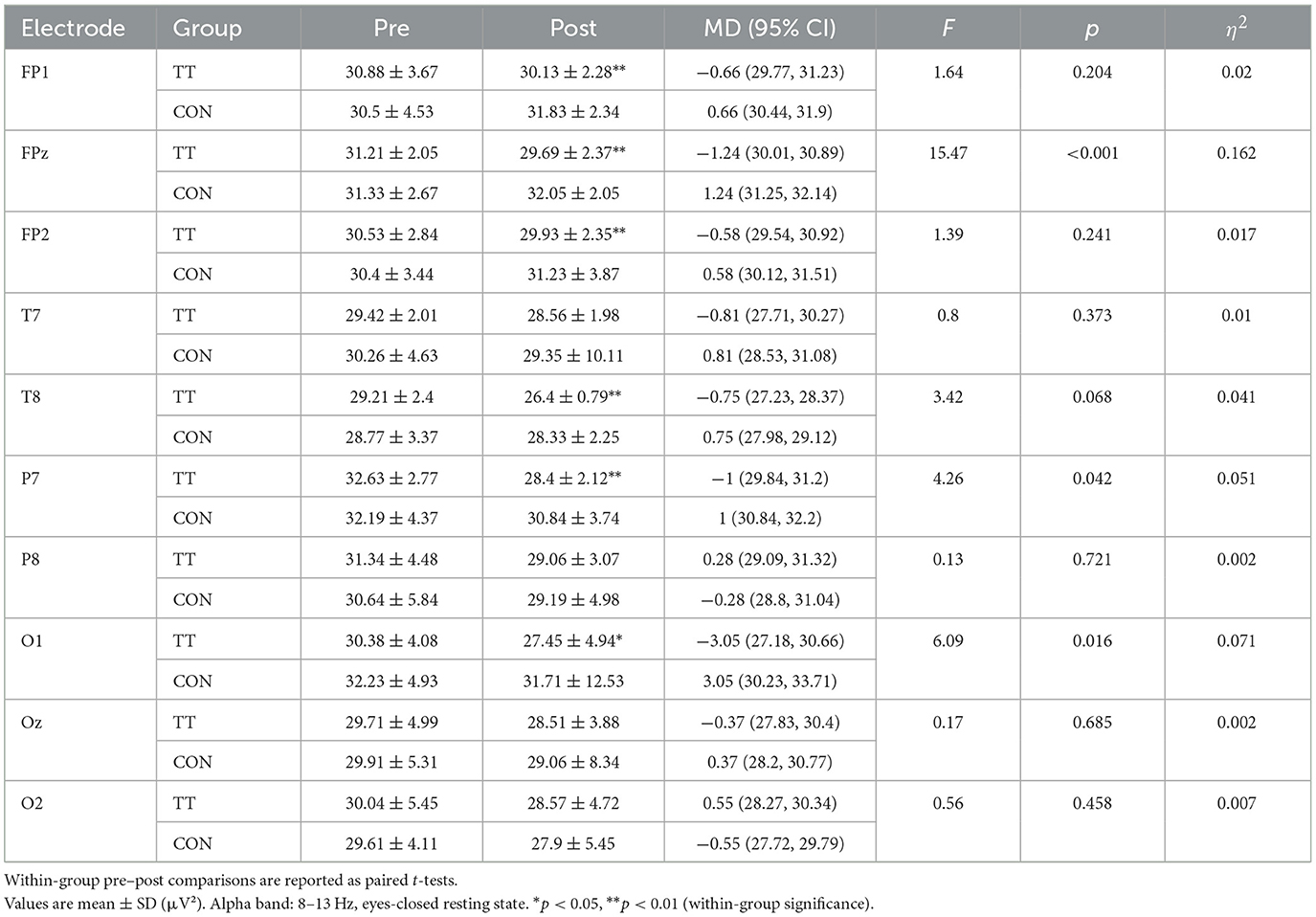
Table 4. Alpha-band (8–13 Hz) absolute power (μV2, mean ± SD) in cognitive-related brain regions at rest (eyes-closed).
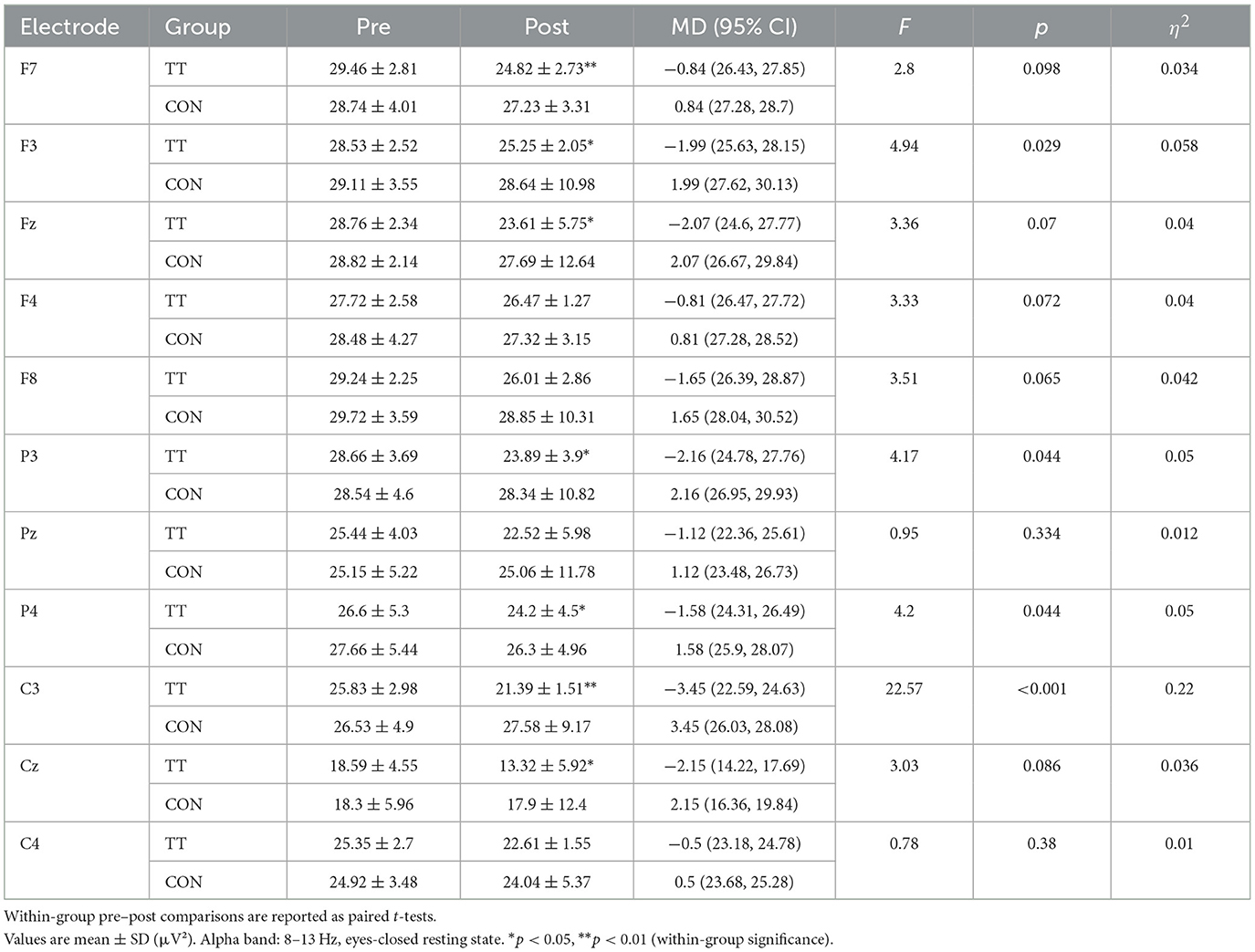
Table 5. Alpha-band (8–13 Hz) absolute power (μV2, mean ± SD) in sensorimotor-related brain regions at rest (eyes-closed).
3.2 Results of brain region functional symmetry
We further examined hemispheric asymmetry by testing the interaction between Group (TT vs. CON), Time (pre vs. post), and Hemisphere (left vs. right). As shown in Table 6, a repeated-measures ANOVA revealed a significant main effect of Group (F = 2.68, p = 0.021, η2 = 0.177), indicating overall differences in EEG power between intervention and control groups. In contrast, neither the main effect of Time (F = 0.22, p = 0.968, η2 = 0.018) nor the Group × Time interaction (F = 0.92, p = 0.482, η2 = 0.069) reached statistical significance, suggesting no global training-related changes.
At the regional level, left–right differences (Δ = Left – Right, mean ± SD) were calculated for prefrontal, temporal, occipital, posterior frontal, parietal, and central regions (Tables 7, 8). Prior to training, no significant hemispheric asymmetry was observed between groups across all regions (p = 0.819, 0.901, and 0.92, respectively). Effect sizes (η2) were generally small across all regions.
3.3 Evaluation of brain region synergy results
As shown in Table 9, the TT group showed no significant correlations among different cognitive function regions before training (p = 0.206, 0.232, and 0.196, respectively). After training, moderate-to-strong positive correlations emerged between the prefrontal–occipital (r = 0.524, p = 0.040) and temporal–occipital (r = 0.71, p = 0.003) regions. In the control group, positive correlations were already present before training (all r > 0.80, p < 0.01), and after training additional associations were observed between the prefrontal–temporal (r = 0.436, p = 0.048) and temporal–occipital (r = 0.812, p < 0.001) regions. As shown in Table 10, both groups exhibited positive correlations among sensorimotor regions both before and after training (all r > 0.65, p < 0.01).
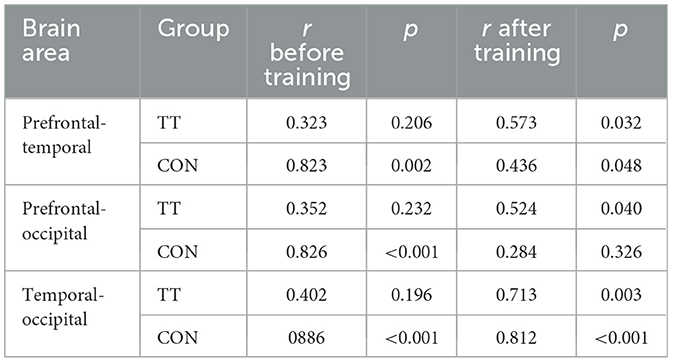
Table 9. Correlation of power among different cognitive function regions within groups, pre- and post-training.
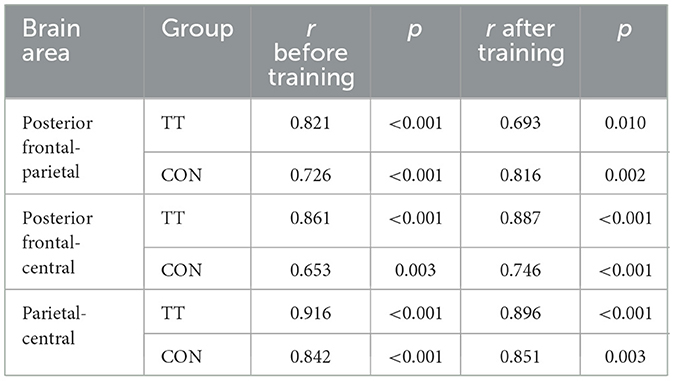
Table 10. Correlation of power among different sensorimotor function regions within groups, pre- and post-training.
As shown in Table 11, exploratory Pearson correlation analyses were conducted between sensorimotor regions (posterior frontal, parietal, central) and cognitive function–related regions (prefrontal, temporal, occipital).
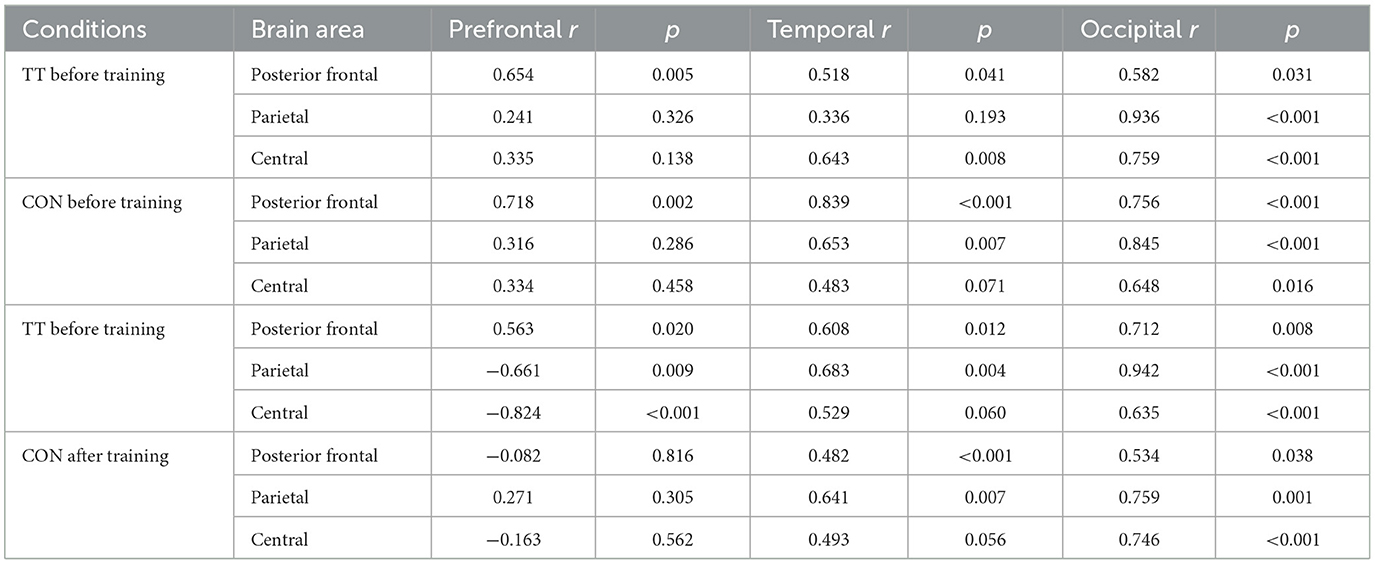
Table 11. Pearson correlation of power between cognitive and sensorimotor function regions within groups, pre- and post-training.
In the TT group, prior to training, several correlations were observed between posterior-frontal and cognitive regions, parietal and occipital regions, as well as central and temporal/occipital regions (r range = −0.82 to 0.78, p < 0.05). These included both positive and negative associations. Following training, correlations appeared more widespread, involving nearly all sensorimotor–cognitive region pairs (r range = −0.71 to 0.87, p < 0.05).
In the control group, pre-training patterns were broadly similar, with correlations detected among posterior-frontal and cognitive regions, parietal and occipital regions, and central and temporal/occipital regions (r range = −0.78 to 0.83, p < 0.05). After training, correlations were primarily observed between posterior-frontal and temporal/occipital regions, parietal and temporal/occipital regions, and central and occipital regions (r range = −0.65 to 0.81, p < 0.05).
Given that no correction for multiple comparisons was applied, these findings should be regarded as preliminary and interpreted with caution.
4 Discussions
In this study, we explored the neural effects of Tan Tui practice in obese college students using EEG. Our findings provide preliminary evidence that this traditional martial arts exercise may modulate brain activity, enhance interhemispheric symmetry, and promote functional coordination among brain regions relevant to motor control. These results offer an initial neurophysiological basis for considering Tan Tui as a potential intervention to support motor function and balance in obese individuals, while acknowledging the exploratory nature of the study.
4.1 The impact of traditional martial arts Tan Tui practice on EEG power
The results of this study show that after 14 weeks of Tan Tui practice, the experimental group exhibited a significant decrease (F = 4.44, p < 0.001, η2 = 0.609) in the absolute power of the alpha band across both cognitive (prefrontal, temporal, occipital) and sensorimotor (posterior frontal, parietal, central) brain regions during a resting-eyes-closed state. Prior studies have consistently linked alpha power reduction—often interpreted as “alpha desynchronization”—to increased cortical excitability and enhanced readiness for information processing (Klimesch, 2012; Jensen and Mazaheri, 2010). Importantly, such desynchronization is not simply an increase in “activity,” but rather reflects the functional reorganization of neural assemblies in preparation for motor or cognitive demands. This aligns with the observed effect sizes in our study, which indicate a moderate-to-strong training effect in key regions involved in postural control.
In contrast, the control group (jogging) showed no significant changes in alpha power after training. This supports the idea that conventional aerobic exercise may not substantially alter neural patterns that underlie complex motor control, which are considered relatively “costly” to reorganize. By contrast, Tan Tui practice significantly reduced alpha power, suggesting that this traditional martial arts training may facilitate neural efficiency—defined as the ability to achieve greater performance with lower or more optimized neural activation (Neubauer and Fink, 2009). This interpretation is reinforced by the consistency of our results with prior motor learning studies, which demonstrate that alpha desynchronization is a robust marker of neural plasticity during skill acquisition and error correction (Ortiz et al., 2023).
Taken together, these findings indicate that Tan Tui training induces functional remodeling of cortical networks in obese college students, beyond the effects of general aerobic activity. The reduction in alpha power, accompanied by moderate-to-large effect sizes, provides converging evidence that this practice enhances the brain's ability to maintain a more “ready” state at rest, thereby enabling more efficient recruitment of neural resources when engaging in postural control tasks.
4.2 The impact of traditional martial arts Tan Tui practice on brain region symmetry
Our study found that Tan Tui practice improved the left-right hemispheric symmetry in TT group (repeated-measures ANOVA revealed a significant main effect of Group with F = 2.68, p = 0.021, η2 = 0.177). This indicates that functional symmetry of motor-related cortices—a crucial neural foundation for coordinated bilateral limb movements and midline stability—was enhanced following training.
Obesity is known to induce uneven body load distribution and altered gait, thereby exacerbating asymmetry in muscle strength and neural control between the two sides of the body (Błaszczyk et al., 2009; Sharma et al., 2024). The design of Tan Tui routines emphasizes “left-right symmetry and reciprocal practice,” requiring equal engagement of both sides of the body (e.g., left vs. right bow stance punches and kicks). Such systematic bilateral training likely facilitates parallel recruitment of the left and right hemispheres during motor planning and execution, strengthening interhemispheric neural connectivity (Yalfani and Raeisi, 2022). Consistent with this interpretation, similar effects have been reported in Taiji and dance, which enhance interhemispheric coordination and motor cortex integration (Chen et al., 2022; Wind et al., 2020).
Importantly, the improvement observed in the central lobe (C3/C4, corresponding to the primary motor cortex, M1) was statistically greater in the Tan Tui group compared to the jogging group suggesting that the benefits were not simply attributable to bilateral movement per se. Jogging, although involving both limbs, is highly automated and imposes fewer demands on precise interhemispheric coordination, which explains the absence of significant improvements in symmetry. In contrast, Tan Tui's symmetrical practice paradigm effectively reshaped the functional balance of the motor cortex in obese college students, representing a key neural mechanism for improving postural control.
4.3 The impact of traditional martial arts Tan Tui practice on brain region synergy
Our results reveal that after training, the experimental group showed enhanced correlations among cognitive regions (e.g., prefrontal–occipital, temporal–occipital) and between cognitive and sensorimotor regions (posterior frontal, parietal, central, and various cognitive areas). Specifically, these functional associations showed moderate-to-strong effect sizes (e.g., posterior-frontal and central r = 0.8611, p < 0.001), suggesting that Tan Tui practice may support more integrated neural communication to meet the complex demands of postural control. While these findings are correlational in nature and were not corrected for multiple comparisons, the consistency across several key networks increases confidence that the effects reflect a genuine trend rather than chance.
Traditional Chinese martial arts emphasize the “unity of internal and external, form and spirit,” which can be framed as the integration of cognitive and sensorimotor processes. Similar interpretations have been proposed in studies of mind–body practices such as yoga, which demonstrate strengthened prefrontal–sensorimotor and multisensory connectivity following training (Villemure et al., 2015). Tan Tui practice similarly requires continuous attention (prefrontal), proprioceptive monitoring (parietal), precise motor execution (central), and multimodal integration (temporal, occipital), thereby providing an ecological platform for the brain to enhance large-scale network cooperation.
In obese individuals, previous work has shown altered functional connectivity patterns, including hyper-connectivity in reward networks (Park et al., 2020) and abnormal synchronization in low-frequency bands (Olde Dubbelink et al., 2008), which may contribute to inefficient cognitive–motor integration. Our results suggest that Tan Tui practice may partially counteract these patterns by promoting long-range functional associations. For example, strengthened prefrontal–sensorimotor correlations indicate stronger top-down control of motor planning, whereas enhanced parietal–occipital–temporal links suggest better multisensory integration. Although further studies with stricter statistical controls (e.g., multiple-comparison correction, graph-theoretic network analysis) are needed, the present findings provide preliminary evidence that Tan Tui practice induces functional reorganization at the whole-brain network level, distinguishing it from more automated exercises such as jogging.
4.4 Limitations
The analyses in this study were conducted in an exploratory manner to identify potential relationships and differences among predefined cognitive and sensorimotor regions of interest (ROIs). Given the limited number of a priori ROIs and the relatively small sample size, uncorrected p-values in correlation analysis were reported to avoid overly conservative adjustments that could obscure meaningful patterns. Nevertheless, these results should be interpreted with caution, and future studies with larger samples and confirmatory designs are warranted to validate these findings with appropriate multiple comparison corrections.
While the control group engaged in jogging matched the intervention group in terms of frequency, duration, and relative exercise intensity (%HRmax), it differed from the Two-Road Tan Tui practice in cognitive-motor complexity. Tan Tui involves coordinated sequences of postures, strikes, kicks, and breathing patterns, requiring continuous motor planning, balance control, and integration of attentional and executive functions. In contrast, jogging primarily constitutes repetitive, rhythmic locomotor activity with minimal cognitive demand.
This difference in movement complexity and cognitive engagement may have contributed to additional neuromuscular and postural benefits in the intervention group, independent of cardiovascular load. Therefore, while the groups were matched for aerobic intensity and total exercise volume, the disparity in motor-cognitive demands represents a potential limitation of the study and should be considered when interpreting the results.
5 Conclusions
This study used traditional martial arts Tan Tui practice as an intervention to explore its effects on the brain mechanisms of postural control in obese college students, using EEG technology. The results show that after 14 weeks of systematic Tan Tui training, the experimental group exhibit enhanced absolute power, improved interhemispheric symmetry, and increased brain region synergy in obese college students. In summary, traditional martial arts Tan Tui practice can serve as an effective exercise intervention for obese adolescents to improve postural control and functional brain imbalances, providing a theoretically and practically distinct pathway rooted in Chinese culture for exercise rehabilitation and promoting brain health.
Data availability statement
The data generated and/or analyzed during the current study are available from the corresponding author upon reasonable request.
Ethics statement
The studies involving humans were approved by Ethics Committee of Southeast University. The studies were conducted in accordance with the local legislation and institutional requirements. Written informed consent for participation in this study was provided by the participants' legal guardians/next of kin.
Author contributions
YL: Methodology, Software, Validation, Writing – original draft. QT: Data curation, Formal analysis, Visualization, Writing – review & editing. QH: Conceptualization, Funding acquisition, Project administration, Writing – review & editing.
Funding
This work was supported by the Fundamental Research Funds for the Central Universities (4018002301); the “14th Five-Year Plan” Special Project of Education Science in Jiangsu Province in 2024: Research on the Shape Spirit Effect of Traditional Martial Arts in Improving Posture Control of Obese College Students from the Perspective of Holistic View (C/2024/01/78); the General Project for Philosophy and Social Science Research in Jiangsu Province Universities in 2025 (2025SJYB0009); the Southeast University Graduate Course Ideological and Political Education Teaching Reform Project (5018002403); the Soft Science Research Project of the Henan Provincial Department of Science and Technology in 2025 (252400410440); the Philosophy and Social Sciences Research Project of Jiangsu Province Universities in 2023 (2023SJYB1585); and the Post-funding Project of the Jiangsu Provincial Social Science Fund: Research on the Construction and Implementation Path of Theoretical System of Physical Education in Colleges and Universities under the Background of Healthy China (2HQB41).
Conflict of interest
The authors declare that the research was conducted in the absence of any commercial or financial relationships that could be construed as a potential conflict of interest.
Generative AI statement
The author(s) declare that no Gen AI was used in the creation of this manuscript.
Any alternative text (alt text) provided alongside figures in this article has been generated by Frontiers with the support of artificial intelligence and reasonable efforts have been made to ensure accuracy, including review by the authors wherever possible. If you identify any issues, please contact us.
Publisher's note
All claims expressed in this article are solely those of the authors and do not necessarily represent those of their affiliated organizations, or those of the publisher, the editors and the reviewers. Any product that may be evaluated in this article, or claim that may be made by its manufacturer, is not guaranteed or endorsed by the publisher.
References
Almurdi, M. M. (2024). Postural balance and functional mobility in relation to BMI and body composition among female students at a College of Applied Medical Sciences: a cross-sectional study. Clinics 79, 100401–100401. doi: 10.1016/j.clinsp.2024.100401
Andreato, L. V., Oliveira, D. V., Follmer, B., and Bertolini, S. M. M. G. (2020). The influence of age and overweight or obesity on foot sensitivity and postural control: a systematic review. Australas. J. Ageing 39, e251–e258. doi: 10.1111/ajag.12782
Başar, E., Başar-Eroglu, C., Karakaş, S., and Schürmann, M. (1999). Are cognitive processes manifested in event-related gamma, alpha, theta and delta oscillations in the EEG? Neurosci. Lett. 259, 165–168. doi: 10.1016/S0304-3940(98)00934-3
Błaszczyk, J. W., Cieślinska-Swider, J., Plewa, M., Zahorska-Markiewicz, B., and Markiewicz, A. (2009). Effects of excessive body weight on postural control. J. Biomech. 42, 1295–1300. doi: 10.1016/j.jbiomech.2009.03.006
Caderby, T., Caron, N., Verkindt, C., Bonazzi, B., Dalleau, G., and Peyrot, N. (2020). Obesity-related alterations in anticipatory postural mechanisms associated with gait initiation. Exp. Brain Res. 238, 2557–2567. doi: 10.1007/s00221-020-05914-8
Cavanagh, J. F., Cohen, M. X., and Allen, J. J. B. (2009). Prelude to and resolution of an error: EEG phase synchrony reveals cognitive control dynamics during action monitoring. J. Neurosci. 29, 98–105. doi: 10.1523/JNEUROSCI.4137-08.2009
Chen, Y., Wan, A., Mao, M., Sun, W., Song, Q., and Mao, D. (2022). Tai Chi practice enables prefrontal cortex bilateral activation and gait performance prioritization during dual-task negotiating obstacle in older adults. Front. Aging Neurosci. 14:1000427. doi: 10.3389/fnagi.2022.1000427
China Martial Arts Association (2013). Rules and Judging Methods for Martial Arts Routine Competitions. Beijing: People's Sports Publishing House.
Choi, J. (2020). Impact of stress levels on eating behaviors among college students. Nutrients 12:1241. doi: 10.3390/nu12051241
Craig, A. D. (2009). How do you feel — now? The anterior insula and human awareness. Nat. Rev. Neurosci. 10, 59–70. doi: 10.1038/nrn2555
de Vos, P., Hanck, C., Neisingh, M., Prak, D., Groen, H., and Faas, M. M. (2015). Weight gain in freshman college students and perceived health. Prev. Med. Rep. 2, 229–234. doi: 10.1016/j.pmedr.2015.03.008
Debnath, A., Kumar, M., Dagar, M., Trivedi, V., Tyagi, A., and Moorthy, A. (2024). Impact of body mass index on coordination, static and dynamic balance in young adults: a case-control study. J. Clin. Diagnostic Res. 18, YC14–YC18. doi: 10.7860/JCDR/2024/73052.20294
do Nascimento, J. A., Silva, C. C., dos Santos, H. H., de Almeida Ferreira, J. J., and de Andrade, P. R. (2017). A preliminary study of static and dynamic balance in sedentary obese young adults: the relationship between BMI, posture and postural balance. Clin. Obes. 7, 377–383. doi: 10.1111/cob.12209
Faul, F., Erdfelder, E., Lang, A.-G., and Buchner, A. (2007). G*Power 3: a flexible statistical power analysis program for the social, behavioral, and biomedical sciences. Behav. Res. Methods 39, 175–191. doi: 10.3758/BF03193146
Garcia-Vicencio, S., Ratel, S., Chalchat, E., Penailillo, L., Kluka, V., Fourot, A.-V., et al. (2023). Combined endurance and strength or only endurance training? Effects of training mode on neuromuscular characteristics and functional abilities in obese adolescent girls enrolled in a weight-reduction program. Adv. Exp. Med. Biol. 143–159. doi: 10.1007/5584_2023_782
Hariyanto, A., Mautang, T. W. E., Usman, A., Akhmad, I., Hartati, H., Nasuka, N., et al. (2025). Differences in food intake, body composition, and physical activity between university students with normal - weight obesity and normal - weight lean. O Mundo da Saúde 49, 1–10. doi: 10.15343/0104-7809.202549e16852024I
Hong, Y., Ullah, R., Wang, J.-B., and Fu, J. (2023). Trends of obesity and overweight among children and adolescents in china. World J. Pediatrics. 19, 1115–1126. doi: 10.1007/s12519-023-00709-7
Huang, J., Keung, V. M. W., Cheung, C. K. M., Lo, A. S. C., Chan, S. C., Wong, Y. Y., et al. (2024). Prevalence and associated factors of overweight in Chinese adolescents: a cross-sectional study. Health Sci. Rep. 7:e2237. doi: 10.1002/hsr2.2237
Jensen, O., and Mazaheri, A. (2010). Shaping functional architecture by oscillatory alpha activity: gating by inhibition. Front. Hum. Neurosci. 4:186. doi: 10.3389/fnhum.2010.00186
Jiang, S., Peng, S., Yang, T., Cottrell, R. R., and Li, L. (2018). Overweight and obesity among chinese college students: an exploration of gender as related to external environmental influences. Am. J. Men's Health 12, 926–934. doi: 10.1177/1557988317750990
Klimesch, W. (2012). Alpha-band oscillations, attention, and controlled access to stored information. Trends Cogn. Sci. 16, 606–617. doi: 10.1016/j.tics.2012.10.007
Li, Y., Li, Y., and Zhang, W. (2021). Effects of different intensity of leg kick exercises on the posture control of students in Taijiquan elective course. China Sport Sci. Technol. 59:599. doi: 10.1186/s13063-024-08447-5
Neubauer, A. C., and Fink, A. (2009). Intelligence and neural efficiency: measures of brain activation versus measures of functional connectivity in the brain. Intelligence 37, 223–229. doi: 10.1016/j.intell.2008.10.008
Odlaug, B. L., Lust, K., Wimmelmann, C. L., Chamberlain, S. R., Mortensen, E. L., Derbyshire, K., et al. (2015). Prevalence and correlates of being overweight or obese in college. Psychiatry Res. 227, 58–64. doi: 10.1016/j.psychres.2015.01.029
Olde Dubbelink, K. T. E., Felius, A., Verbunt, J. P. A., van Dijk, B. W., Berendse, H. W., Stam, C. J., et al. (2008). Increased resting-state functional connectivity in obese adolescents: a magnetoencephalographic pilot study. PLoS ONE 3:e2827. doi: 10.1371/journal.pone.0002827
Ortiz, O., Kuruganti, U., Chester, V., Wilson, A., and Blustein, D. H. (2023). Changes in EEG alpha-band power during prehension indicates neural motor drive inhibition. J. Neurophysiol. 130, 1588–1601. doi: 10.1152/jn.00506.2022
Park, B., Byeon, K., Lee, M. J., Chung, C., Kim, S., Morys, F., et al. (2020). Whole-brain functional connectivity correlates of obesity phenotypes. Hum. Brain Mapp. 41, 4912–4924. doi: 10.1002/hbm.25167
Schack, T., and Mechsner, F. (2006). Representation of motor skills in human long-term memory. Neurosci. Lett. 391, 77–81. doi: 10.1016/j.neulet.2005.10.009
Sharma, A., Dhiman, S., Jha, N., and Kundra, S. (2024). Impact of obesity on balance and musculoskeletal flexibility in primary school children. J. Soc. Indian Physiotherapists. 40, 120–156. doi: 10.4103/jsip.jsip_81_24
Strashko, Y. Y., Morokhovets, H. Y., Stetsenko, S. A., Berezhna, V. A., Kondratieva, Y. O., Horsha, O. V., et al. (2022). Biomechanical aspects of posture control of the human body. World Med. Biol. 18, 181–181. doi: 10.26724/2079-8334-2022-4-82-181-186
Villemure, C., ÄŒeko, M., Cotton, V. A., and Bushnell, M. C. (2015). Neuroprotective effects of yoga practice: age-, experience-, and frequency-dependent plasticity. Front. Hum. Neurosci. 9:281. doi: 10.3389/fnhum.2015.00281
Wind, J., Horst, F., Rizzi, N., John, A., and Schöllhorn, W. I. (2020). Electrical brain activity and its functional connectivity in the physical execution of modern Jazz dance. Front. Psychol. 11:586076. doi: 10.3389/fpsyg.2020.586076
Wu, B., and Wu, D. (2017). Research of Tantui Quan. Res. Wushu 27, 55–61. doi: 10.13293/j.cnki.wskx.006549
Wulf, G., and Lewthwaite, R. (2016). Optimizing performance through intrinsic motivation and attention for learning: the OPTIMAL theory of motor learning. Psychonomic Bull. Rev. 23, 1382–1414. doi: 10.3758/s13423-015-0999-9
Yalfani, A., and Raeisi, Z. (2022). Bilateral symmetry of vertical time to stabilization in postural sway after double-leg landing in elite athletes with unilateral chronic ankle sprain. J. Foot Ankle Res. 15:43. doi: 10.1186/s13047-022-00552-5
Keywords: traditional martial arts, postural control, brain function, obese college students, EEG
Citation: Li Y, Tang Q and Huang Q (2025) A study on the brain mechanisms of postural control improvement in obese college students through traditional martial arts Tan Tui practice. Front. Psychol. 16:1681295. doi: 10.3389/fpsyg.2025.1681295
Received: 07 August 2025; Accepted: 17 September 2025;
Published: 09 October 2025.
Edited by:
F. Neşe Şahin, Ankara University, TürkiyeReviewed by:
Carlos Humberto Andrade-Moraes, Federal University of Rio de Janeiro, BrazilFaik Öz, Ondokuz May?s University, Türkiye
Copyright © 2025 Li, Tang and Huang. This is an open-access article distributed under the terms of the Creative Commons Attribution License (CC BY). The use, distribution or reproduction in other forums is permitted, provided the original author(s) and the copyright owner(s) are credited and that the original publication in this journal is cited, in accordance with accepted academic practice. No use, distribution or reproduction is permitted which does not comply with these terms.
*Correspondence: Qiao Huang, U2ltb24xOTcwMDIzMUBwcm90b25tYWlsLmNvbQ==
 Youhua Li1
Youhua Li1 Qiao Huang
Qiao Huang